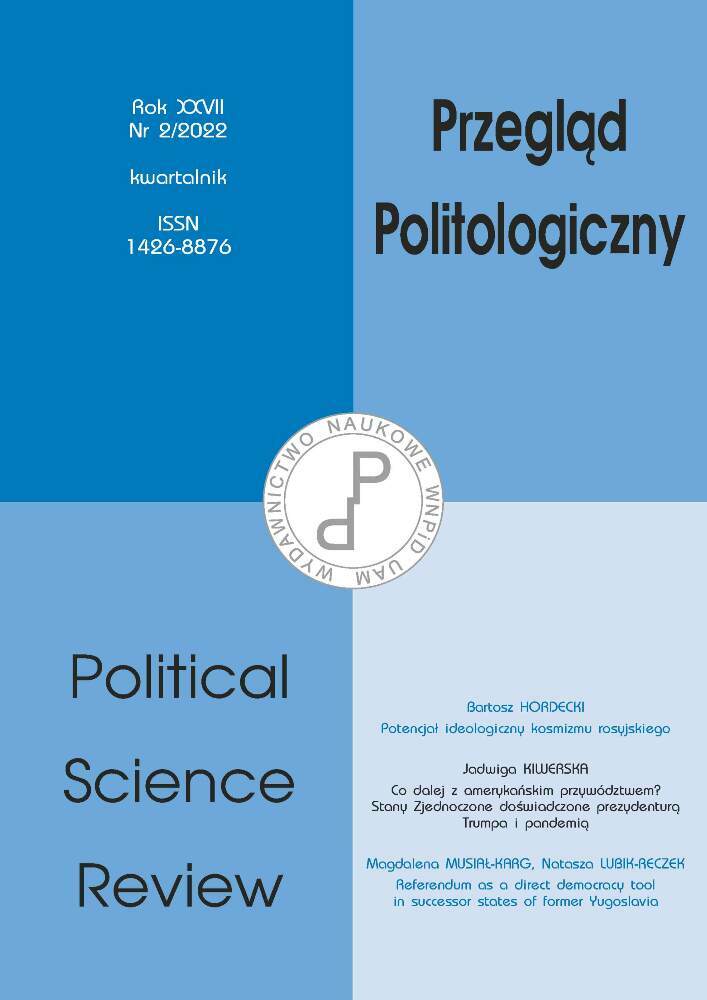Abstract
The purpose of the study is the structure of political parties and comparative analysis of the party system in the Republic of India. The objective of the research is to investigate the functioning of the parties, power structure, dynamics and their role in forming the government at the centre and state levels in the country. In addition, the study analyses the approaches of the parties as an actor to make a coalition government in various provincial governments. The research used comparative method analysis to achieve the purpose of this study and describe the source methods for testing the research objectives. The study finds the comprehensive relevance of parties’ role in the Indian political system. Finally, the result of the article finds as a conclusion that the multi-party system provides multiple opportunities for people to participate in the democratic process in India.
References
Arian A., Barnes S. H. (1974), The dominant party system: A neglected model of democratic stability, “The Journal of Politics”, vol. 36, no. 3.
Beasley R., Kaarbo J. (2014), Explaining extremity in the foreign policies of parliamentary democracies, “International Studies Quarterly”, vol. 58, no. 4.
Blarel N., Van Willigen N. (2021), How do regional parties influence foreign policy? Insights from multilevel coalitional bargaining in India, “European Journal of International Relations”, vol. 27, no. 2.
Brancati D. (2008), The origins and strengths of regional parties, “British Journal of political science”, vol. 38, no. 1.
Chhibber P. (2006), Duvergerian Dynamics in the Indian States: Federalism and the Number of Parties in the State Assembly Elections, “Party Politics”, vol. 12, no. 1.
Chhibber, P., Nooruddin I. (2004), Do Party Systems Count? The Number of Parties and Government Performance in the Indian States, “Comparative Political Studies”, vol. 37, no. 2.
Coticchia F., Davidson J. W. (2018), The limits of radical parties in coalition foreign policy: Italy, hijacking, and the extremity hypothesis, “Foreign Policy Analysis”, vol. 14, no. 2.
Cox G. W. (1997), Making votes count: Strategic coordination in the world’s electoral systems, Cambridge University Press, Cambridge.
Diwakar R. (2017), Change and continuity in Indian politics and the Indian party system: Revisiting the results of the 2014 Indian general election, “Asian Journal of Comparative Politics”, vol. 2, no. 4.
Downs A. (1957), An economic theory of democracy, Harper, New York.
Duverger M. (1959), Political Parties, 2nd edn., Methuen, London.
Election Commission of India (2014), General Election 2014, https://eci.gov.in/files/category/97-general-election-2014/, 1.03.2022.
Election Commission of India (2019), General Election 2019, https://eci.gov.in/files/category/1551-general-election-2019-including-vellore-pc/, 01.03.2022.
Greene T. (2019), Foreign policy anarchy in multiparty coalitions: when junior parties take rogue decisions, “European Journal of International Relations”, vol. 25, no. 3.
Kailash K. K. (2014), Regional Parties in the 16th Lok Sabha Elections: Who Survived and Why?, “Economic and Political Weekly”, vol. 49, no. 39.
Kesalu S. V. (2013), Genesis and Evaluation Political Parties in India, “International Research Journal Social Science”, vol. 2, no. 2.
Laakso M., Taagepara R. (1979), Effective number of parties: A measure with application to West Europe, “Comparative Political Studies”, vol. 12.
Lahiri A. K. (2000), Sub-national public finance in India, “Economic and Political Weekly”, vol. 35, no. 4.
Lipset S. M., Rokkan S. (1967), Cleavage structures, party systems, and voter alignments: an introduction, in: Party systems and voter alignments, eds. Seymour Martin Lipset, Stein Rokkan, 1–64, Free Press, New York.
Reddy T. (2005), The congress party model: South Africa’s African National Congress (ANC) and India’s Indian National Congress (INC) as dominant parties, “African and Asian Studies”, vol. 4, no. 3.
Sartori G. (1976), Parties and Party Systems: A Framework for Analysis, Cambridge University Press, Cambridge.
Soikham P. (2019), Revisiting a dominant party: Normative dynamics of the Indian National Congress, “Asian Journal of Comparative Politics”, vol. 4, no. 1.
Southall R. (2005), The dominant party debate in South Africa, “Afrika Spectrum”, vol. 39.
Stoll H. (2004), Social Cleavages, Political Institutions, and Party Systems (Doctoral dissertation, PhD Thesis, Department of Political Sciences, Stanford University).
Suri K. C., Elliott C., Hundt D. (2016), Democracy, governance and political parties in India: An introduction, “Studies in Indian Politics”, vol. 4, no. 1.
Vallier I., Apter D. E. (1971), Comparative Methods in Sociology. Essays on trends and applications, University of California Press.
Verbeek B., Zaslove A. (2015), The impact of populist radical right parties on Foreign policy: The Northern League as a Junior Coalition Partner in the Berlusconi Governments, “European Political Science Review”, vol. 7, no. 4.
Wyatt A. (2009), Party system change in South India: Political entrepreneurs, patterns and processes, Routledge.
Yadav Y. (1996), Reconfiguration in Indian Politics: State Assembly Elections, 1993–95’, “Economic and Political Weekly”, January 13–20.
Ziegfeld A. (2012), Coalition Government and Party System Change: Explaining the Rise of Regional Political Parties in India, “Comparative Politics”, vol. 45, no. 1.

